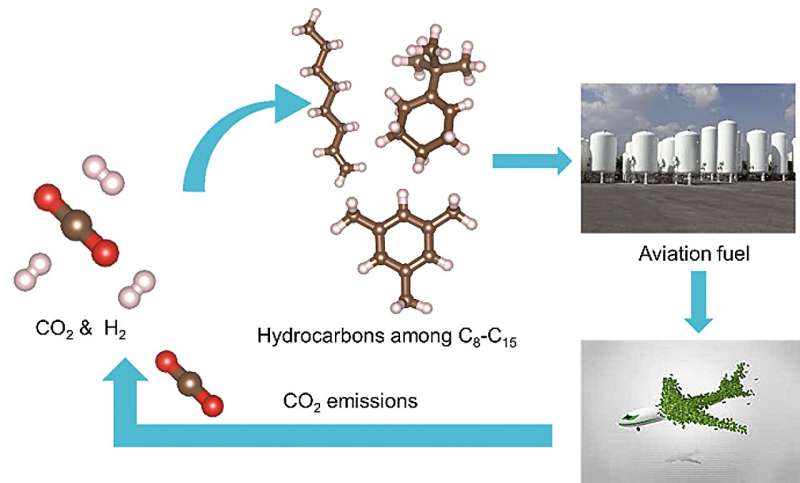This article has been reviewed according to Science X's editorial process and policies. Editors have highlighted the following attributes while ensuring the content's credibility:
fact-checked
proofread
Fueling the future: Researchers evaluate emissions in the aviation industry

A research group led Prof. Fei Wei and Chenxi Zhang in Tsinghua University has published a perspective paper that evaluates the progression from deep-rooted fossil-fuel-dependent technologies to innovative strategies aimed at carbon neutrality, with a specific focus on the formulation of sustainable aviation fuel from CO2.
The paper provides an analytical review of the cutting-edge methodologies for CO2-to-jet fuel conversion with an assessment of the practicality of current industrial models.
On April 10, 2024, their perspective paper was published in Carbon Future.
The concentration of greenhouse gases has steeply increased in the atmosphere due to dependency on carbon-intensive energy sources. In particular, CO2 and CH4 have been especially challenging to reincorporate into the chemical industry because of high energy demands and current technological constraints. Amid this great challenge, numerous governments have adopted different strategies to reduce carbon emissions.
"Among the diverse strategies employed for the recycling of carbon emissions, such as CO2 and CH4, for application in the chemical industry, the integration of renewable energy sources to transform carbon emissions into value-added products is a viable pathway.
"Therefore, committing to the development of renewable energy is not only the key to controlling CO2 emissions as a responsible country, but also an inevitable choice for energy independence," said Wei, a professor at Tsinghua University.
The team notes the ways that countries are working in the area of renewable energy. The European Union's Renewable Energy Directive III represents a seminal step in this direction, setting a precedent for the integration of sustainable energy practices within statutory mandates. They also note the accelerated research progress in China, especially in the area of photovoltaic (PV) technology.
"A significant surge in solar PV and wind system endeavors has been witnessed in China, as evidenced by the investment in intellectual property, which accounts for the first place globally in this domain. In addition, the complete industrial chain of renewable energy provides development opportunities for CO2 to Sustainable Aviation Fuel (SAF)," said Wei.
Sustainable Aviation Fuel (SAF) refers to a liquid hydrocarbon fuel derived from non-fossil resources, that is, green jet fuel. Aviation fuel uses C-C and C-H chemical bonds as energy storage, and its energy density is 80 times that of commercial lithium-ion batteries. The huge gap in energy density makes it difficult for the aviation field to quickly achieve electrification, so SAF has become the main route to net-zero emissions in the world's aviation industry.
By the end of 2020, a total of 65 countries around the world had implemented mandatory blending policies for SAF, and by 2027, ICAO's Carbon Reduction Offset Mechanism (CORSIA) will be fully enforced. The European Union (EU) Renewable Energy Directive stipulates that the proportion of SAF blending shall not be less than 5% in 2030 and 70% in 2050, of which the proportion of electric fuels produced through carbon dioxide capture (eFuel) shall not be less than 35% by 2050.
And the U.S. Inflation Reduction Act (IRA) provides a tax deduction for SAF, aiming to achieve 100% SAF as an alternative to fossil fuels for aviation fuel by 2050. The aviation industry's "green barrier" allows SAF to sell for four times as much as petroleum-based jet fuel, making SAF the "holy grail" of the energy sector and a precursor to the profitable process of green energy.
The "CO2 to SAF (CO2AFTM)" technology harnesses CO2 as a carbon feedstock, integrating it with green hydrogen produced via electrolysis of water using renewable energy sources such as wind or solar. This process synthesizes liquid jet fuel that boasts a high energy density.
"Sustainable aviation fuel (SAF) plays a key role in ensuring national energy security in the aerospace sector and achieving net-zero emissions in the world's aviation industry. This approach utilizes liquid fuel as a novel form of energy storage across seasons and years; concurrently, renewable aviation fuel is recognized globally in the aviation industry as a viable pathway for carbon reduction. The high added value of this process establishes it as an important, profitable industrialization method," said Wei.
The research team includes Guo Tian, Zhang, and Fei Wei. They work at the Beijing Key Laboratory of Green Chemical Reaction Engineering and Technology, Department of Chemical Engineering, Tsinghua University, Beijing, China. Zhang also works at Ordos Laboratory and the Institute for Carbon Neutrality at Tsinghua University. Wei also works at Ordos Laboratory.
More information: Guo Tian et al, Fueling the future: Innovating the path to carbon-neutral skies with CO2-to-aviation fuel, Carbon Future (2024). DOI: 10.26599/CF.2024.9200010




















